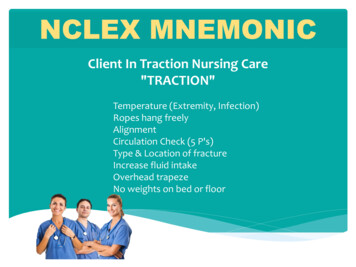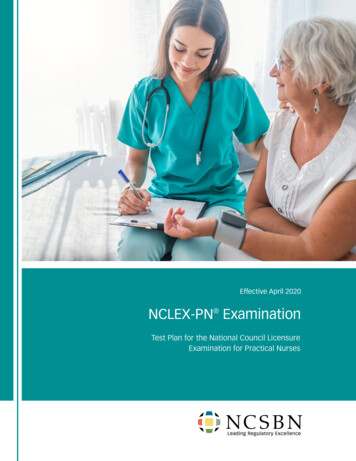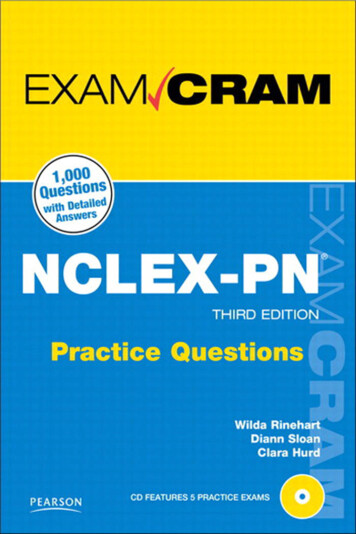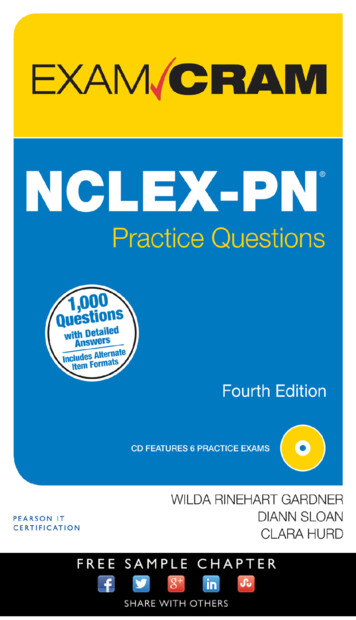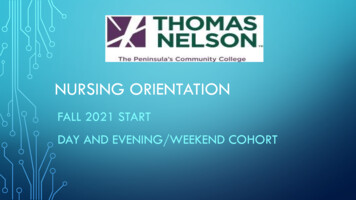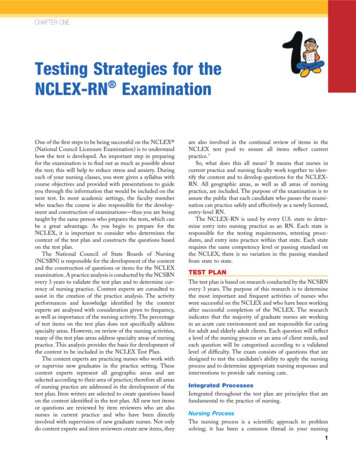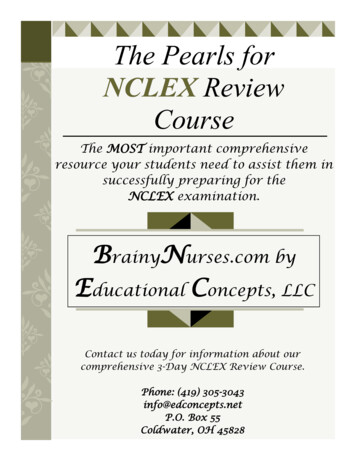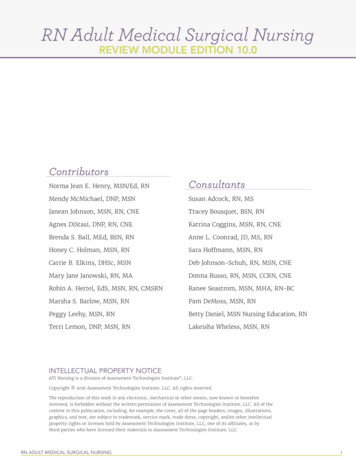
Transcription
Nursing Curricula and theNCLEX Exam:Traveling a Path to SuccessMaryAnn Hogan, MSN, RNWest Palm Beach, FLJanuary 24, 2011
Session Objectives:Summarize what has changed in thecurrent NCLEX RN and PN test plans.Describe a process for mapping nursingcurricula to the NCLEX test plan to reduceor eliminate curricular gaps or overlaps.Explore various ways of integratingNCLEX style test questions into courses ina nursing curriculum.
Overview of the NCLEX Licensing Exam for RNsand LPN/LVNs
Exam OverviewComputer adaptive test (CAT)Each question classified by client need,integrated process, and is assigned a levelof difficulty after being pretestedNumber of Questions:– RN: 75-265; 15 pretest items– PN: 85-205; 25 pretest items
Exam OverviewMaximum time:– RN: 6 hrs; PN: 5 hrs– Time includes tutorial, sample items,breaks (all breaks are optional), andexamDrop down calculator availableCandidate reads question, selects andconfirms answer to move to next question
Exam OverviewExam delivers questions until 95% certaintyof candidate meeting or not meetingpassing standard, answers maximum # ofquestions or runs out of time.Passing standard:– RN: -0.16 logits 2010 (-0.21 2007; -0.28 2004)– PN: -0.27 logits 2011 (-0.37 2008; -0.42 2005)– Logit (log odds unit) is described athttps://www.ncsbn.org/02 18 05 brief.pdf
NCLEX Framework: Client NeedsSafe Effective Care Environment:– Management of Care (RN test plan 2010)16-22% (13-19% 2007)– Coordinated Care (PN test plan 2011)13-19% (12-18% 2008)Safe Effective Care Environment:– Safety and Infection ControlRN test plan 2010: 8-14% (unchanged)PN test plan 2011: 11-17% (8-14% in 2008)
NCLEX Framework: Client NeedsHealth Promotion and Maintenance– RN test plan 2010: 6-12% (unchanged)– PN test plan 2011: 7-13% (unchanged)Psychosocial Integrity– RN test plan 2010: 6-12% (unchanged0– PN test plan 2011: 7-13% (8-14% 2008)
NCLEX Framework: Client NeedsPhysiological Integrity– Basic Care and ComfortRN test plan 2010: 6-12% (unchanged)PN test plan 2011: 9-15% (11-17% 2008)– Pharmacological and ParenteralTherapiesRN test plan 2010: 13-19% (unchanged)PN test plan 2011: 11-17% (9-15% 2008)
NCLEX Framework: Client NeedsPhysiological Integrity– Reduction of Risk PotentialRN test plan 2010: 10-16% (13-19% 2007)PN test plan 2011: 9-15% (10-16% 2008)– Physiological AdaptationRN test plan 2010: 11-17% (unchanged)PN test plan 2011: 9-15% (11-17% 2008)
Integrated Processes (IP)A second framework used for test itemsFour processes:– Nursing process (RN) or clinical problemsolving process (PN)– Caring– Communication and documentation– Teaching/LearningEach question addresses 1 of these but IPsare not assigned percentages on test plan
Test Item TypesStandard 4-option multiple choice(with or without added graphics)Alternate item formats– Multiple response– Fill-in-the-blank– Hot spot– Chart/Exhibit– Drag and drop/Ordered response– Audio– Graphic Options
Example: Multiple ResponseThe nurse admits a client from the emergencydepartment who has a left ventricular myocardialinfarction. To detect onset of left sided heart failure,the nurse assesses this client for whichmanifestations? Select all that apply. Jugular venous distention Hepatomegaly Dyspnea Crackles Tachycardia Right upper quadrant pain
Example: Fill-in-the-BlankThe nurse completes a fluid balance record for a clientresuming a diet on the 2nd postoperative day. The client hasthe following data recorded for the shift. How manymilliliters should the nurse document as intake?Intake:Output:Answer:6 oz orange juice4 oz water640 mL 5% Dextrose in Water IV4 oz chicken broth850 mL urine60 mL Hemovac drainage1060mL
Example: Hot Spot ItemThe nurse receives atelephone report fromradiology that a clienthas a 10%pneumothorax on theright. The nurse wouldexpect to hear absentbreath sounds in whatarea if the client’s headof bed is elevated 60degrees?
Chart ExhibitA client is admitted to the nursing unit. After reviewing theclient’s chart, which laboratory test would be mostimportant for the nurse to monitor?1.2.3.4.Serum potassiumBlood urea nitrogenSerum ammoniaSerum osmolalityClient’s ChartMedicationsHistory & PhysicalDiagnostic Tests
An adult client is admitted to the medical-surgical nursing unit. Afterreviewing the client’s chart, the nurse would place highest priority onmonitoring which laboratory test result? Click on the Exhibit buttonbelow for additional information.1. Serum potassium2. Blood urea nitrogen3. Serum ammonia4. Serum osmolalitySelect the best response. Click the Next button (N) or the Enter key to confirm answer and proceed.Previous (P)Next (N)Exhibit (E)Calculator (C)
An adult client is admitted to the medical-surgical nursing unit. Afterreviewing the client’s chart, the nurse would place highest priority onmonitoring which laboratory test result? Click on the Exhibit buttonbelow for additional information.1. Serum potassiumHistoryMedicationsSigns2. Blood urea nitrogenCirrhosis of the liver3. Serum ammoniaDiabetes Mellitus4. Serum osmolalityPeripheral arterial disease1 of 3Close (L)Tile (T)GlaucomaSelect the best response. Click the Next button (N) or the Enter key to confirm answer and proceed.Previous (P)Next (N)Exhibit (E)Calculator (C)
An adult client is admitted to the medical-surgical nursing unit. Afterreviewing the client’s chart, the nurse would place highest priority onmonitoring which laboratory test result? Click on the Exhibit buttonbelow for additional information.1. Serum potassium2. Blood urea nitrogen3. Serum ammonia4. Serum osmolalityHistoryMedicationsSignslactulose (Cephulac) 30 mL pothree times dailyglyburide (DiaBeta) 5 mg podaily2 of 3Close (L)Tile (T)clopidogrel (Plavix) 75 mg podailybetaxolol (Betoptic) 2 dropsright eye dailySelect the best response. Click the Next button (N) or the Enter key to confirm answer and proceed.Previous (P)Next (N)Exhibit (E)Calculator (C)
An adult client is admitted to the medical-surgical nursing unit. Afterreviewing the client’s chart, the nurse would place highest priority onmonitoring which laboratory test result? Click on the Exhibit buttonbelow for additional information.1. Serum potassium2. Blood urea nitrogenMedicationsHistoryTime8:00 A.M.Neurological SignsAwake but disorientedto time and place8:00 P.M.Awake but disorientedto time and place8:00 A.M.Lethargic, arouses withrepeated verbalstimulation3. Serum ammonia4. Serum osmolalitySigns3 of 3Close (L)Tile (T)Select the best response. Click the Next button (N) or the Enter key to confirm answer and proceed.Previous (P)Next (N)Exhibit (E)Calculator (C)
An adult client is admitted to the medical-surgical nursing unit. Afterreviewing the client’s chart, the nurse would place highest priority onmonitoring which laboratory test result? Click on the Exhibit buttonbelow for additional information.1. Serum potassium2. Blood urea nitrogen3. Serum ammonia4. Serum osmolalitySelect the best response. Click the Next button (N) or the Enter key to confirm answer and proceed.Previous (P)Next (N)Exhibit (E)Calculator (C)
Drag and Drop(click)/Ordered ResponseThe client does not respond or move when the nurseverbally calls the client’s name upon entering the room.What sequence of actions would the nurse use toresuscitate the client?Establish unresponsivenessOpen the airwayCheck for breathingGive two breathsCheck carotid pulsePerform chest compressions
NCLEX Question Formats#7 Audio or Media (“New”)(Audio/media control buttons go here)In tutorial, examinee is told to put on headset and click play button tolisten to audioclip. Adjust volume if needed by moving slider. Click playto repeat if needed.After listening to the client’s heart sounds, which abnormalheart sound would the nurse report to the health careprovider?o 1. S3o 2. S4o 3. Systolic murmuro 4. Diastolic murmur
NCLEX Question Formats #8 Graphic (“New”)A neonate was born with a ventricular septaldefect. Which diagram would the nurse use toteach the parents about the newborn’s condition?
Where to find more?See other examples athttps://www.ncsbn.org/2007 NCLEX RNDetailed Test Plan Candidate.pdforhttps://www.ncsbn.org/2008 PN DetailedTest Plan Candidate.pdf
Mapping a Curriculum to theNCLEX Test Plan
Mapping a Curriculum to theNCLEX Test PlanAdvantages:– Ensures licensing exam content is addressedin the nursing program– Provides one measure of ongoing QI that mayhelp with accreditation– Should help achieve higher pass rates onNCLEX licensing exam (but this ismultifactorial!)
Mapping a Curriculum to theNCLEX Test PlanDisadvantages/blocks to plan for:– Lack of clerical help to set up template grids– Time consuming process if thoughtfully done– May compete with other currentresponsibilities of faculty– May or may not be seen as a priority byfaculty
Process for Mapping a Curriculumto the NCLEX Test PlanDesign grid for completion at course level
Process for Mapping a Curriculumto the NCLEX Test PlanDesign summary grid of all courses in curriculum
Process for Mapping a Curriculumto the NCLEX Test PlanIdentify areas of excessive overlap (ratherthan planned reinforcement) and considerreducingIdentify gaps and plan for inclusion ofinsufficient or missing contentDocument (committee minutes) curricularrevisions for future reference and asevidence of ongoing program evaluationFollow up to ensure planned changes takeplace and “stick”
Integrating NCLEX Style TestQuestions into Courses in aNursing Curriculum
Designing AppropriateLevel Test Questions:What Bloom’s TaxonomyLevel to Use?
Cognitive Levels: gAnalyzingApplyingUnderstandingRemembering
Cognitive LevelsNCLEX exam items: predominantly atapplication and analysis levels (criticalthinking)Critically important to introduce students todifficult questions systematically duringnursing programCan be accomplished using questionsinterjected in class and on teacher-madetests
Remembering (Knowledge)LevelRemember or recognize terminology,facts, ideas, materials, trends, sequences,methodology, principles, andgeneralizations.Fundamentally useful in testing students’acquisition of factual information abouthealth and illness during a courseThis level is NOT tested on the NCLEX exams
Understanding(Comprehension) LevelUnderstand directions, writtencommunications, reports, tables,diagrams, and regulationsUseful in determining that student candraw inferences from information (but notnecessarily relate it to other material orsee its fullest implications)There are few of these items on theNCLEX exam and they would generallyhave a lower difficulty level
Sample (Understanding)Comprehension Level QuestionA client is admitted with diarrhea caused byvancomycin resistant enterococcus. Whatprecautions should the nurse initiate for thisclient?1.2.3.4.Droplet precautionsAirborne precautionsContact precautionsNeutropenic precautions
Applying (Application) LevelApply principles, procedures, methods,formulas, theories or ideas in job (nursingpractice) related situationsUseful to perform a task, solve a problem,or obtain a particular resultFrequently tested on NCLEX exam asthis simulates a “real-world” situation innursing and these questions can bewritten at varying difficulty levels
Sample Application Level QuestionThe nurse is assigned to the care of a client withdiarrhea caused by vancomycin resistantenterococcus. What action would the nurse take?1. Keep the door to the client’s room closed.2. Place disposable masks outside the client’s room.3. Put on a disposable gown before giving the clienta bath*4. Move the client to a room with negative airpressure
Analyzing (Analysis) LevelBreak down information or material into parts anddetect relationship of those parts and the waythey are organizedUseful to dissect and analyze informationpresented, and/or distinguish between critical andnon-critical dataAt least two or more pieces of data are gatheredand interpreted usually before deciding a courseof actionTend to be most difficult level of question overall;targeted area for NCLEX test item development
Sample Analysis Level QuestionThe nurse would intervene after seeing anunlicensed assistive person (UAP) take whichaction?1. Elevate the head of bed for a client who just hadabdominal surgery for bowel obstruction2. Assist a client with Parkinson’s disease toambulate to the bathroom3. Apply mask and gloves to bathe a client with avancomycin resistant enterococcus infection*4. Give a cup of ice cream to a client who has awhite blood cell count of 3500/mm3
Infusing Critical Thinkinginto Test ItemsDesign questions that use multi-logicalthinking– “Thinking that requires knowledge of morethan one fact to logically and systematicallyapply concepts to a clinical problem”– Must know more than one concept or fact toanswer the question– Cannot find the answer on a single page oftextbook– Apply concepts to clinical scenarios inquestions
Samples of Critical ThinkingImbedded in Test ItemsDiscriminate important from unimportant dataAnalyze information and predict an outcomeDevelop a plan of careApply standard of carePrioritize interventions and job responsibilitiesDelegate careEvaluate interventions and teaching
Critical Thinking:Word Clues in Question StemsFirstInitiallyMostEssentialHighest priorityBest
Checklist to Ensure CriticalThinking Test Items9 Written at application or analysis level9 Is clear and easy to read9 Requires multi-logical thinking to answer9 Contains “critical words”9 All options are plausible (these can be difficult towrite!); high level of discrimination is needed tochoose correctly9 Textbook supports all correct answers (mayneed multiple pages to verify)
Designing Test Blueprints
Why Use a Test Blueprint?Identifies objective/skills to be measuredStates the number of items per objective,avoiding under- or over-representation ofareasEnsures content validitySpecifies range of item difficulty forquestionsMore likely to include questions thatmeasure important content and skills,instead of ones that are “easy to write”
Sample Blueprint: Study QuestionsBased on Class ObjectivesWhat are the etiology and/or risk factors for this healthproblem?What are the associated nursing assessment and labfindings for this health problem?What nursing care and teaching are associated with thediagnostic studies for this health problem?What are appropriate nursing diagnoses and goals ofcare for this health problem?What is the expected and appropriate therapeutic(medical or surgical) management for this healthproblem?What would be included in the nursing care andmanagement of a client with this health problem?What client teaching is appropriate for someone with thishealth problem?
Sample Blueprint: Senior LevelAdult Health Unit Test
Final Thoughts on Test BlueprintingVery difficult questions can also be used asbonus questions in a testCognitive level blueprinting can be doneacross nursing courses with increasingnumbers of higher level questions withprogression in the curriculumIs not a perfect science-problems with testitems often become evident after use
Final Thoughts on Test ItemsFind flaws by examining item analysis and revisequestions immediately (while fresh in mind) forfuture use–––Too difficultToo easyMore than one correct answerHint: also make decisions about such items andadjust grade in current test before releasing gradeand test review; avoids being defensive withstudents and reduces student tendency to argueabout questions
Final Thoughts on Test ItemsUse textbook test bank items carefully; theycan have flawsRevise a known flawed question beforeusing them in your test (up to 5 times fasterto revise a nonfunctional test item than towrite a new one; ex: 6 minutes versus 30)Insert sample questions at beginning,during and end of class to enhance studentengagement and aid application ofknowledge (don’t use on actual test)
Discussion and Questions
current NCLEX RN and PN test plans. Describe a process for mapping nursing curricula to the NCLEX test plan to reduce or eliminate curricular gaps or overlaps. Explore various ways of integrating NCLEX style test

